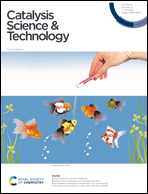Ru supported on activated carbon and coated with a polydopamine layer for effective acetylene hydrochlorination†
Abstract
Considering the disadvantages of ruthenium-based catalysts for acetylene hydrochlorination, such as poor dispersion, metal loss, serious carbon deposition, and insufficient active sites, supported ruthenium catalysts coated with polydopamine (Ru/AC@PDA-T) were synthesized by using the self-polymerization of dopamine to attach a protective layer on Ru/AC. The PDA-derived layer formed a local active domain depending on the complexation of its heteroatomic structure to the Ru atom. Benefiting from the promotion of local structural forces, the synthetic process resulted in highly dispersed active components, although a certain size of Ru nanoclusters rather than some monatomic species was most favorable for catalyzing the reaction. Ruthenium species were stabilized in their active states. The superior activity might be caused by the synergistic adsorption and activation of reactants by Ru–O/N multi-sites, significantly reducing the catalytic energy barrier, promoting rapid reaction and impeding carbon deposition, which promotes the continuous exposure of active sites and thus improves the catalytic efficiency. Significantly improved activity and stability provide for a potential industrial application of the optimized Ru/AC@PDA-100 catalyst.



 Please wait while we load your content...
Please wait while we load your content...